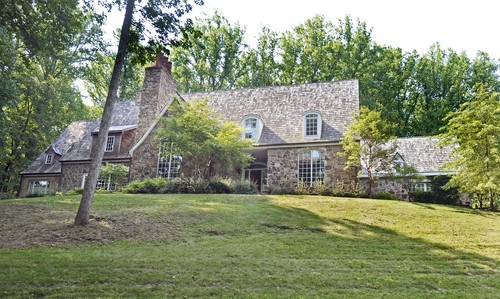Million-dollar mistake to end in land swap
City deal to settle fate of house built in wrong place
The $1.3 million house near the Loch Raven Reservoir was built with an eye toward details - handcrafted ceilings, a wood-paneled library - but missed a critical one: It sits on land owned not by the homeowner but the City of Baltimore. After years of negotiation and pending final approval, the city and the homeowner, Todd B. Garliss Jr., will swap their adjacent parcels of land: Garliss will give the city his four-acre property and the city will give him the three acres on which his house and private road sits. He'll also pay the city back rent. (Baltimore Sun photo by Kenneth K. Lam / July 16, 2009)
By Annie Linskey | annie.linskey@baltsun.com
July 17, 2009
The $1.3 million Baltimore County home is billed in a real estate ad as an "architectural gem" with five bedrooms, seven bathrooms, winter views of Loch Raven Reservoir and "moldings and details beyond anyone's imagination."
But there is a significant hitch: The builder, Todd B. Garliss Sr., constructed the mansion on the wrong piece of land, putting it not on his own plot but on adjacent property owned by Baltimore City.
The city, believing Garliss made an honest mistake, is now poised to enter an unusual land swap with his son, the current owner of the house, to clear up the matter. Under the deal, which was introduced as legislation to the Baltimore City Council on Monday, the city would take ownership of Todd B. Garliss Jr.'s four-acre property and give him the adjacent city-owned three acres on which the home sits.
Garliss will not be allowed to make any additions to the house, which is in Phoenix off Poplar Hill Road and surrounded by land that, like the nearby reservoir, is owned by the city. He also must pay the city $65,000 in rent for having used the city land all these years.
"They had the misfortune to build a nice house on what I think they thought was their land," said City Solicitor George A. Nilson. "They relied on a [land] survey that was not all that it should have been."
Intent was critical to Nilson. "It is not like these people came in and just plunked down a house," he said. "They did own this parcel. The boundary just wasn't what they thought it was."
But the city's top lawyer acknowledges the deal looks odd. "The cynic's view could be: 'Did they do this on purpose?' " Nilson said.
The younger Garliss declined to be interviewed for this story. The elder Garliss could not be reached.
Bob Douglas, an attorney for Garliss Jr., lays the blame for the mix-up on a faulty, undated land survey conducted by Terra Plan Inc., a now-defunct company that was based in Reisterstown.
"This is the biggest ball of spaghetti that I've ever been involved with trying to unwind with land deals," Douglas said.
The property in question is near Loch Raven Reservoir, one of three city-owned reservoirs in the county. The city owns about 24,500 acres of land around those reservoirs, including 8,000 around Loch Raven.
The city purchased property around Loch Raven from the Warren Manufacturing Co. for $1 million in 1922, though the Garliss property was apparently one slice of privately held property the city did not acquire. The Garliss family acquired it in the 1990s, Douglas said.
The elder Garliss applied to Baltimore County for permits to build a house there in 1995, and submitted the Terra Plan survey with his application papers, Douglas said. The county approved the application and issued additional building permits in 1996 and 1997, Douglas said.
Garliss then sold the property to his son in 1998 for $685,000 and the title was transferred with no problem, Douglas said. The house was completed in 2000, according to online property records.
The son tried to sell it in 2005, but the deal fell through after a prospective buyer ordered a title report and it showed that some of the property's driveway was on city-owned land.
"The first title report said the driveway only overlapped a little," Douglas said. "They thought they were only talking about a couple of feet of intrusion."
Baltimore City was notified, and the city's surveyor came to a much different conclusion: The entire house was built on city land, as was much of the private road that leads to Poplar Hill Road. In fact, only two minor portions of the road were on the land that Garliss owns.
When city lawyers first learned of the house, they planned to sue the owner, said Cheryle L. Wilson, who had worked on the case for years. "We wanted to go after them," Wilson said.
But she found no evidence that Garliss intentionally built on the wrong piece of land and concluded that a Baltimore County judge would likely not order the house bulldozed or given to the city. Instead a judge would probably order some type of land swap after a costly legal battle, city lawyers said.
"At the end of the day there was a decent enough chance that a Baltimore County judge could have said, 'I'm not going to make these people tear it down,' " Nilson said. "So we could have ended up with the same deal."
Legislation was introduced in the City Council on Monday to allow the city to sell its three acres. If the council passes that bill, the land deal will go to the city's Board of Estimates for approval.
If approved by the City Council and Board of Estimates, the city will take ownership of the four-acre Garliss plot, appraised at $320,000. Garliss will get three acres of city land, worth $345,000.
Though the city's land is worth $25,000 more, Wilson does not believe the city is losing in the deal because she said the appraisal is based on commercial attributes of the property - whether it is level, and the ease of building on it - and the city has no plans to construct there.
"From our point of view the extra acre of watershed land is more valuable," she said.
Garliss will also pay $65,000 for three years of "renting" the land. Wilson determined the amount assessing rental costs for similar nearby property. The city decided to charge for three years because that is the statute of limitations that the law gives the city to sue.
Now with City Council legislation pending, the house is back on the market. An enthusiastic real estate advertisement describes the house as having "exquisite flooring, handcrafted ceilings, oversized drop dead gorgous [sic] kit/fam room, magnificent den ... and so much more!"
Photos online show a stone house with a pitched roof and glass picture windows. Interior shots show a wood-paneled library, high ceilings, wood floors, a sunny kitchen, a fireplace and a master bedroom with a walk-in closet and a fireplace.
There is one offer on the house.
Sun researcher Paul McCardell contributed to this article.
Copyright © 2009, The Baltimore Sun





